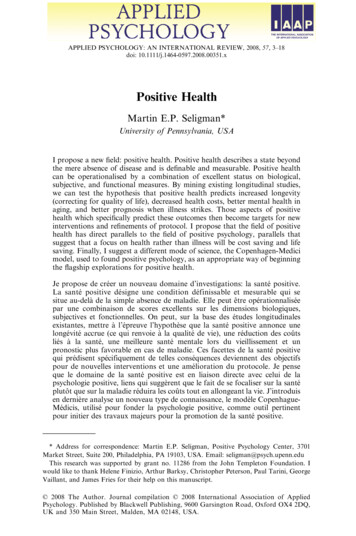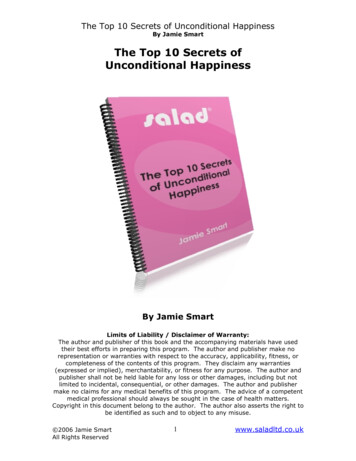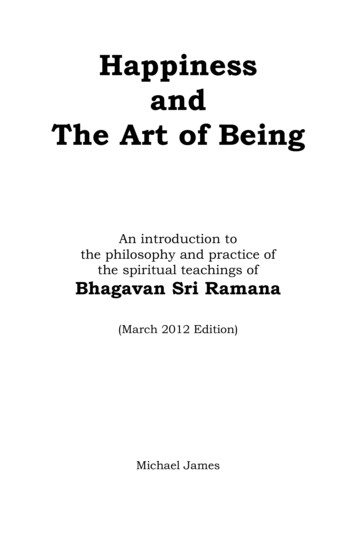
Transcription
HappinessandThe Art of BeingAn introduction tothe philosophy and practice ofthe spiritual teachings ofBhagavan Sri Ramana(March 2012 Edition)Michael James
Copyright 2006, 2007, 2012 Michael D A JamesAll rights reserved.No part of this publication may be reproduced, except for briefand duly acknowledged quotations, or as expressly permitted by law,without the prior permission in writing of the author.First PDF edition: December 2006Second PDF edition: March 2007Third PDF edition: August 2007First print edition (Canada): August 2007First print edition (India): August 2007Second print edition (US): March 2012Second print edition (India): March 2012Fourth PDF edition: March 2012First Kindle edition: March 2012This PDF copy of the March 2012 editionpublished by CreateSpace (ISBN 978-1475111576)is available for free download on the author’s website atwww.happinessofbeing.com/Happiness and the Art of Being.pdfOther translations and writings on the teachings of Sri Ramanaby Michael James are available on his website and fbeing.blogspot.comFor information about the author’s books available on Amazonplease visitwww.amazon.com/author/michaeljames
DEDICATIONToBhagavan Sri Ramana,who taught me all that I know,and gave whatever inspiration created this book,and to his closest disciples,especiallySri Sivaprakasam Pillai,who first elicited and recorded his basic teachings,which he later formed into his precious treatiseNāṉ Yār? (Who am I?),Sri Muruganar,who not only elicited his finest philosophical poems and verses,but also recorded his oral teachingsmost comprehensively, profoundly and poetically inGuru Vācaka Kōvai,andSri Sadhu Om,who helped me to understand his teachingsmore clearly and deeply.
ContentsPageIntroduction11 What is Happiness?492 Who am I?733 The Nature of Our Mind1274 The Nature of Reality1815 What is True Knowledge?2216 True Knowledge and False Knowledge2737 The Illusion of Time and Space2998 The Science of Consciousness3179 Self-Investigation and Self-Surrender33110 The Practice of the Art of Being373Bibliography465Transliteration and Pronunciation469Glossary473
IntroductionHappiness lies deep within us, in the very core of our being. Happiness doesnot exist in any external object, but only in us, who are the consciousnessthat experiences happiness. Though we seem to derive happiness fromexternal objects or experiences, the happiness that we thus enjoy in factarises from within us.Whatever turmoil our mind may be in, in the centre of our being therealways exists a state of perfect peace and joy, like the calm in the eye of astorm. Desire and fear agitate our mind, and obscure from its view thehappiness that always exists within it. When a desire is satisfied, or thecause of a fear is removed, the surface agitation of our mind subsides, and inthat temporary calm our mind enjoys a taste of its own innate happiness.Happiness is thus a state of being – a state in which our mind’s habitualagitation is calmed. The activity of our mind disturbs it from its calm stateof just being, and causes it to lose sight of its own innermost happiness. Toenjoy happiness, therefore, all our mind need do is to cease all activity,returning calmly to its natural state of inactive being, as it does daily in deepsleep.Therefore to master the art of being happy, we must master the art andscience of just being. We must discover what the innermost core of ourbeing is, and we must learn to abide consciously and constantly in that stateof pure being, which underlies and supports (but nevertheless remainsunaffected by) all the superficial activities of our mind: thinking, feeling andperceiving, remembering and forgetting, and so on.The art of just being, remaining fully conscious but without any activityof the mind, is not only an art – a practical skill that can be cultivated andapplied to produce an experience of inexpressible beauty and joy – but alsoa science – an attempt to acquire true knowledge by keen observation andrigorous experiment. And this art and science of being is not only the art andscience of happiness, but also the art and science of consciousness, and theart and science of self-knowledge.The science of being is incredibly simple and clear. To the human mind,however, it may appear to be complex and abstruse, not because it is in anyway complex in itself, but because the mind which tries to comprehend it issuch a complex bundle of thoughts and emotions – desires, fears, anxieties,attachments, long-cherished beliefs and preconceived ideas – that it tends to1
2HAPPINESS AND THE ART OF BEINGcloud the pure simplicity and clarity of being, making what is obviousappear to be obscure.Like any other science, the science of being begins with observation andanalysis of something that we already know but do not fully understand, andproceeds by reasoning to formulate a plausible hypothesis that can explainwhat is observed, and then rigorously tests that hypothesis by precise andcritical experiment. However, unlike all other sciences, this science does notstudy any object of knowledge, but instead studies the very power ofknowing itself – the power of consciousness that underlies the mind, thepower by which all objects are known.Hence the truth discovered by means of this science is not something thatcan be demonstrated or proved objectively by one person to another. It can,however, be directly experienced as a clear knowledge in the innermost coreof each person who scrupulously pursues the necessary process ofexperiment till the true nature of being – which is the true nature ofconsciousness, and of happiness – is revealed in the full clarity of pureunadulterated self-consciousness.Just as the science of being is fundamentally unlike all other sciences, soas an art it is fundamentally unlike all other arts, because it is not an art thatinvolves doing anything. It is an art not of doing but of non-doing – an art ofjust being.The state of just being is one in which our mind does not rise to do, thinkor know anything, yet it is a state of full consciousness – consciousness notof anything else but only of being. The skill that is to be learnt in this art isnot simply the skill to be – because we always are and therefore require nospecial skill or effort to be –, nor is it merely the skill to be without doing orthinking anything – because we are able to be so each day in deep dreamlesssleep. The skill to be cultivated is the skill to remain calmly and peacefullywithout doing or thinking anything, but nevertheless retaining a perfectlyclear consciousness of being – that is, consciousness of our own being oressential ‘am’-ness. Only in this pristine state of clear non-dual selfconscious being, unclouded by the distracting agitation of thought andaction, will the true nature of being become perfectly clear, obvious, selfevident and free from even the least scope for doubt or confusion.Our first and most direct experience of being is that of our own being orexistence. First we know that we exist, and then only can we know of theexistence of other things. But whereas our own existence is self-conscious,the existence of each other thing depends on us to be known.We know our own being because we are consciousness. In other words,our being is itself the consciousness that knows itself. It knows itselfbecause it is essentially self-conscious. Thus it is reasonable to hypothesisethat consciousness is the primal and essential form of being. Without
INTRODUCTION3consciousness, being would be unknown, and without being, consciousnesswould not exist.Our being and our consciousness of being are inseparable – in fact theyare identical – and both are expressed by the single phrase ‘I am’. Thisbeing-consciousness, ‘I am’, is our most fundamental experience, and themost fundamental experience of every sentient being. ‘I am’ is the one basicconsciousness – the essential non-dual self-consciousness – without whichnothing would be known. ‘I am’ is therefore the source and foundation of allknowledge.What then is the use of knowing anything else if we do not know the truthof our own being-consciousness, our self-consciousness, ‘I am’, on the basisof which all else is known? All that we know about the world and all that weknow about God – all our sciences and all our religions – are of no realvalue to us if we do not know the truth about ourself, who desire to knowthe truth about the world and God.We are the being-consciousness ‘I am’, yet our knowledge about this ‘Iam’ is confused. We all believe ‘I am this body’, ‘I am a person’, ‘I amcalled so-and-so, and was born on such-and-such a date at such-and-such aplace’. Thus we identify our consciousness ‘I am’ with a particular body.This identification is the result of a confused and unclear knowledge of thetrue nature of consciousness.Our consciousness ‘I am’ is not something material, whereas our body ismerely a bundle of physical matter, which is not inherently conscious. Yetsomehow we are deluded into mistaking this material body to be ourconsciousness ‘I’. As a result of our unclear knowledge of consciousness,we mistake matter to be conscious, and consciousness to be somethingmaterial.That which thus mistakes this body to be ‘I’ is our mind. Our mind comesinto existence only by imagining itself to be a body. In deep sleep we areunaware of either our mind or our body. As soon as we wake up, our mindrises feeling ‘I am this body, I am so-and-so’, and only after thus identifyingitself as a particular body does it perceive the external world through thefive senses of that body.Exactly the same thing happens in dream – our mind identifies itself as aparticular body and through the five senses of that body it perceives aseemingly real and external world. When we wake up from a dream, weunderstand that the body we mistook to be ‘I’ and the world we mistook tobe real and external were both in fact only figments of our imagination.Thus from our experience in dream we all know that our mind has awonderful power of imagination by which it is able to create a body, tomistake that imaginary body to be ‘I’, and through that body to project aworld which, at the time we perceive it, appears to be every bit as real and
4HAPPINESS AND THE ART OF BEINGexternal to us as the world that we now perceive in this waking state.Knowing that our mind possesses this wonderful power of creation andself-deception, is it not reasonable for us to suspect that the body we take tobe ‘I’ and the world we take to be real in our present waking state may infact be nothing more than a mere imagination or mental projection, just likethe body and world that we experience in dream? What evidence do we havethat the body and world we experience in this waking state are anythingother than a creation of our own mind? We may be able to point out certaindifferences between waking and dream, but on analysis we will discover thatthose differences are superficial, being concerned with quality or quantityrather than with substance.If we compare the world drama we see in waking or dream to a drama wesee on a cinema screen, we may say that the drama seen in waking is a betterquality and more impressive production than that seen in dream, but both areproductions none the less – productions not of some external agency but ofour mind which sees them.In substance, there is no essential difference between our experience inwaking and that in dream. In both states our mind rises, attaching itself to abody by taking it to be ‘I’, and through the senses of that body it sees aworld bound within the limits of time and space, and filled with numerouspeople and other objects, both sentient and insentient, all of which it isconvinced are real. How can we prove to ourself that what we experience inthe waking state exists at all outside our own imagination, any more than adream exists outside our imagination?When we carefully analyse our experience in our three states of waking,dream and deep sleep, it is clear that we are able to confuse ourconsciousness ‘I’ to be different things at different times. In waking wemistake our present body to be ‘I’, in dream we mistake some otherimaginary body to be ‘I’, and in sleep we mistake unconsciousness to be ‘I’– or at least on waking from sleep what we remember is that ‘I wasunconscious’.What we were in fact unconscious of in sleep was our mind, our body andthe world, but not our own existence or being. Our experience in sleep wasnot that we ceased to exist, but only that we ceased to be aware of all thethoughts and perceptions that we are accustomed to experiencing in thewaking and dream states. When we say, ‘I slept peacefully, I had no dreams,I was unaware of anything’, we are confidently affirming that ‘I’ was insleep – that is, that we existed and knew that we existed at that time.Because we associate consciousness with being conscious of all thethoughts and perceptions that make up our life in waking and in dream, weconsider sleep to be a state of unconsciousness. But we should examine theso-called unconsciousness of sleep more carefully. The consciousness thatknows thoughts and perceptions is our mind, which rises and is active in
INTRODUCTION5waking and dream, but which subsides in sleep. But this rising andsubsiding consciousness is not our real consciousness. We are conscious notonly of the two states of waking and dream, in which our mind rises toexperience thoughts and perceptions, but also of a third state, sleep, in whichour mind has subsided in a state devoid of thoughts and perceptions.This fact that we are conscious of sleep as a state distinct from wakingand dream clearly indicates that we are the consciousness that underlies therising and subsiding of the transient consciousness that we call ‘mind’. Theconsciousness that enables us to affirm confidently, ‘I did exist in sleep, butI was unconscious of anything’, is not our ‘rising consciousness’ but our‘being consciousness’.This ‘being consciousness’, which exists in all our three states, is our realconsciousness, and is what is truly denoted when we say ‘I am’. Our mind,the ‘rising consciousness’ that appears in waking and dream and disappearsin sleep, is only a spurious form of consciousness, which on rising mistakesitself to be both our basic consciousness ‘I am’ and this material body.Thus, by analysing our experience in our three states of waking, dreamand deep sleep, we can understand that though we now mistake ourself to bea body limited by time and space, we are in fact the consciousness thatunderlies the appearance of these three states, in only two of which the senseof being a body and the consequent limitations of time and space areexperienced.However, a mere theoretical understanding of the truth that we are onlyconsciousness will be of little use to us if we do not apply it in practice byendeavouring to gain real experiential knowledge of that truth. By itself, atheoretical understanding will not and cannot give us true and lastinghappiness, because it cannot destroy our deep-rooted sense of identificationwith the body, which is the root of all ignorance, and the cause of all misery.That which understands this truth theoretically is only our mind orintellect, and our mind cannot function without first identifying itself with abody. Since our mind or intellect is thus a confused knowledge whoseexistence is rooted in ignorance about who or what we really are, nointellectual understanding can ever by itself give us true self-knowledge.Self-knowledge can only be gained by direct experience of the pureunlimited consciousness which is our real self, because only such experiencecan root out the ignorance that we are anything other than thatconsciousness.Therefore a theoretical understanding of the truth can be of real benefit tous only if it prompts us to investigate our essential consciousness of being –our simple self-consciousness, ‘I am’ – and thereby attain through directexperience a clear knowledge of our own true nature. Only by attaining sucha clear knowledge of the consciousness that is truly ‘I’, can we destroy our
6HAPPINESS AND THE ART OF BEINGprimal ignorance, the confused and mistaken knowledge that we are themind, the limited form of consciousness that identifies a body as ‘I’.If we truly understand that we are not a body, nor the mind whichimagines itself to be a body, and that every form of unhappiness that weexperience is caused only by our mistaken identification with a body, wewill endeavour to destroy that false identification by undertaking practicalresearch to discover who or what we really are. To know what we really are,we must cease attending to any other things, and must attend instead toourself, the consciousness that knows those other things.When we attend to things other than ‘I’, our attention is a ‘thought’ oractivity of the mind. But when we attend to our essential consciousness ‘I’,our attention ceases to be an activity or ‘thought’, and instead becomes merebeing. We know other things by an act of knowing, but we know ourself notby an act of knowing but by merely being ourself. Therefore, when weattend to the innermost core of our being – that is, to our essential and realself, which is simple thought-free non-dual self-conscious being – we ceaseto rise as the incessantly active mind and instead remain merely as ournaturally actionless consciousness of being. Therefore self-attention is selfabidance, the state of merely being what we really are.So long as we attend to things other than ourself, our mind is active, andits activity clouds and obscures our natural clarity of self-consciousness. Butwhen we try to attend to ourself, the activity of our mind begins to subside,and thus the veil that obscures our natural self-consciousness begins todissolve. The more keenly and intensely we focus our attention upon ourbasic consciousness ‘I’, the more our mind will subside, until finally itdisappears in the clear light of true self-knowledge.In this book, therefore, I will attempt to explain both the theory and thepractice of the art of knowing and being our real self. The theory of thisscience and art of self-knowledge is necessary and helpful to us insofar as itenables us to understand not only the imperative need for us to know thereality, but also the practical means by which we can achieve suchknowledge.All the unhappiness, discontent and misery that we experience in our lifeis caused only by our ignorance or confused knowledge of who or what wereally are. So long as we limit ourself by identifying a body as ‘I’, we willfeel desire for whatever we think is necessary for our survival in that body,and for whatever we think will make our life in that body more comfortableand pleasant. Likewise we will feel fear and dislike of whatever we thinkthreatens our survival in that body, and of whatever we think will make ourlife in it less comfortable or pleasant. When we do not get whatever wedesire or like, and when we cannot avoid whatever we fear or dislike, wefeel unhappy, discontented or miserable.
INTRODUCTION7Thus unhappiness or suffering is the inevitable result of desire and fear,or likes and dislikes. Desire and fear, and likes and dislikes, are theinevitable result of identifying a body as ‘I’. And identifying a body as ‘I’results from our lack of clear knowledge of our real nature – our essentialself-conscious being. Therefore if we want to be free of all forms of miseryand unhappiness, we must free ourself from our ignorance or confusedknowledge of what we really are.In order to free ourself from this confused knowledge, which makes usfeel that we are a body, we must attain a clear knowledge of our real self.The only means by which we can attain such clear self-knowledge is to turnour attention away from our body, our mind and all other things, and tofocus it keenly upon our own essential self-consciousness – our fundamentalconsciousness of our own being, ‘I am’.Thus the theory that underlies the science and art of self-knowledgeenables us to understand that all we need do in order to experience perfectand unlimited happiness is to attain true self-knowledge, and that the onlymeans to attain true self-knowledge is to practise keen scrutinising selfattention. Unless we know ourself as we really are, we can never experiencetrue and perfect happiness, untainted by even the least unhappiness ordissatisfaction, and unless we keenly attend to our essential consciousness ofour own mere being – our simple non-dual self-consciousness, ‘I am’ – wecan never know ourself as we really are.For the majority of spiritual aspirants, the process of attaining selfknowledge, like the process of learning any other art or science, is said to bea threefold process of repeated śravaṇa, manana and nididhyāsana, orlearning, assimilation and practice. The Sanskrit word śravaṇa literallymeans ‘hearing’, but in this context it means learning the truth by hearing,reading or studying. The word manana means thinking, pondering, musing,reflection or meditation, that is, dwelling frequently upon the truth that wehave learnt through śravaṇa in order to imbibe it and understand it more andmore clearly, and to impress it upon our mind more and more firmly. Andthe word nididhyāsana means keen observation, scrutiny, attentiveness orprofound contemplation, that is, in our context, putting what we have learntand understood by śravaṇa and manana into practice by keenly scrutinising,attending to or contemplating upon our essential self-conscious being, ‘Iam’.In the life of a serious spiritual aspirant, this threefold process of śravaṇa,manana and nididhyāsana should continue repeatedly until the experienceof true self-knowledge is attained. In our day-to-day lives our mindencounters innumerable different impressions through our five senses, andthinks innumerable thoughts about those impressions, so the impressionmade by one thing is quickly replaced by the impression made by other
8HAPPINESS AND THE ART OF BEINGthings. Therefore even though we have once learnt about the spiritual truth –the truth that we are not the limited body but are only the unlimited spirit orconsciousness – the impression made by that truth will quickly fade if we donot repeatedly study books that remind us of it, and frequently reflect uponit in our mind.However mere reading and thinking about the truth will be of little benefitto us if we do not also repeatedly attempt to put it into practice by turningour attention back to our mere consciousness of being, I am’, whenever wenotice that it has slipped away to think of other things. To stress theparamount importance of such practice, Sri Adi Sankara declared in verse364 of Vivēkacūḍāmaṇi that the benefit of manana is a hundred timesgreater than that of śravaṇa, and the benefit of nididhyāsana is a hundredthousand times greater than that of manana.For some very rare souls, repeated śravaṇa, manana and nididhyāsana isnot necessary, because as soon as they first hear the truth, they at once graspits meaning and importance, turn their attention selfwards, and therebyimmediately experience true self-knowledge. But the majority of us do nothave the spiritual maturity to be able to experience the truth as soon as wehear it, because we are too strongly attached to our existence as anindividual person, and to all that is associated with our life as a person.By repeated nididhyāsana or self-contemplation, supported by the aid ofrepeated śravaṇa and manana, our consciousness of our own essential beingand our corresponding understanding of the truth will become increasinglyclear, and by that increasing clarity we will steadily gain more love to knowourself as we really are, and more detachment from our individuality and allthat is associated with it. Therefore, until we gain such true spiritualmaturity – the willingness and love to lose our individual self in theexperience of true non-dual self-knowledge – we have to continue theprocess of repeated śravaṇa, manana and nididhyāsana.Even more rare than those highly mature souls who are able to experiencethe truth as soon as they hear it, there are some people who without everhearing the truth experience it spontaneously. But such people are very rareindeed.All that I write in this book is what I have learnt and understood from theteachings of the sage known as Bhagavan Sri Ramana Maharshi, who wasone such extremely rare being who experienced the truth spontaneouslywithout ever having heard or read anything about it. He spontaneouslyattained the experience of true self-knowledge one day in July 1896, whenhe was just a sixteen-year-old schoolboy. That day he was sitting alone in aroom in his uncle’s house in the south Indian town of Madurai, whensuddenly and with no apparent cause an intense fear of death arose withinhim. Instead of trying to put this fear out of his mind, as most of us would
INTRODUCTION9do, he decided to investigate and discover for himself the truth about death.‘All right, death has come! What is death? What is it that dies? This bodyis going to die – let it die.’ Deciding thus, he lay down like a corpse, rigidand without breathing, and turned his mind inwards to discover what deathwould actually do to him. He later described the truth that dawned upon himat that moment as follows:‘This body is dead. It will now be taken to the cremation ground, burnt,and reduced to ashes. But with the destruction of this body, am I alsodestroyed? Is this body really “I”? Although this body is lying lifeless as acorpse, I know that I am. Unaffected in the least by this death, my being isshining clearly. Therefore I am not this body which dies. I am the “I” whichis indestructible. Of all things, I alone am the reality. This body is subject todeath, but I, who transcend the body, am that which lives eternally. Thedeath that came to this body cannot affect me.’Although he described his experience of death in so many words, heexplained that this truth actually dawned upon him in an instant, not asreasoning or verbalised thoughts, but as a direct experience, without theleast action of mind. So intense was his fear and consequent urge to knowthe truth of death, that without actually thinking anything he turned hisattention away from his rigid and lifeless body and towards the innermostcore of his being – his essential, unadulterated and non-dual selfconsciousness ‘I am’. Because his attention was so keenly focused on hisconsciousness of being, the true nature of that being-consciousness revealeditself as a flash of direct and certain knowledge – knowledge that was sodirect and certain that it could never be doubted.Thus Sri Ramana discovered himself to be the pure transpersonalconsciousness ‘I am’, which is the one, unlimited, undivided and non-dualwhole, the only existing reality, the source and substance of all things, andthe true self of every living being. This knowledge of his real naturedestroyed in him for ever the sense of identification with the physical body –the feeling of being an individual person, a separate conscious entityconfined within the limits of a particular time and place.Along with this dawn of non-dual self-knowledge, the truth of everythingelse became clear to him. By knowing himself to be the infinite spirit, thefundamental consciousness ‘I am’, in which and through which all otherthings are known, he knew as an immediate experience how those otherthings appear and disappear in this essential consciousness. Thus he knewwithout the least doubt that everything that appears and disappears dependsfor its seeming existence upon this fundamental consciousness, which heknew to be his real self.When reading some of the recorded accounts of his death experience, peopleoften get the impression that when he lay down like a corpse, Sri Ramana
10HAPPINESS AND THE ART OF BEINGmerely simulated the signs of physical death. But he explained on severaloccasions that he did not merely simulate it, but actually underwent theexperience of physical death at that time. Because he fixed his wholeattention so firmly and intensely upon his non-dual consciousness of being,not only did his breathing cease, but his heart stopped beating, and all theother biological functions that indicate life also came to a standstill. Thus hisbody literally lay lifeless for about twenty minutes, until suddenly lifesurged through it once again, and his heartbeat and breath started to functionas normal.However, though life returned to his physical body, the person who hadpreviously identified that body as ‘I’ was dead, having been destroyedforever by the clear light of true self-knowledge. But though he had died asan individual person, he had thereby been born again as the infinite spirit –the fundamental and unlimited consciousness of being, the non-dual selfconsciousness ‘I am’.Though outwardly he appeared to behave as an individual person, hispersonality was in fact just an appearance that existed only in the view ofother people, like the charred form of a rope that remains after the rope itselfhas been burnt. Inwardly he knew himself to be the all-inclusiveconsciousness that transcends all limitations, and not merely a separateindividual consciousness confined within the limits of a particular body.Therefore, the conscious being that other people saw acting through hisbody was not really an individual person at all, but was only the supremespirit – the infinite and absolute reality that we usually refer to as ‘God’.Soon after this true self-knowledge dawned upon him, Sri Ramana left hischildhood home and travelled a few hundred miles north to Tiruvannamalai,a temple town nestled at the foot of the holy mountain Arunachala, where helived as a sādhu or religious mendicant for the remaining fifty-four years ofhis bodily life. Since he had ceased to identify himself with the body thatother people mistook to be him, he also cease
a science – an attempt to acquire true knowledge by keen observation and rigorous experiment. And this art and science of being is not only the art and science of happiness, but also the art and science of consciousness, and the art and science of self-knowledge. The science of being is incredi
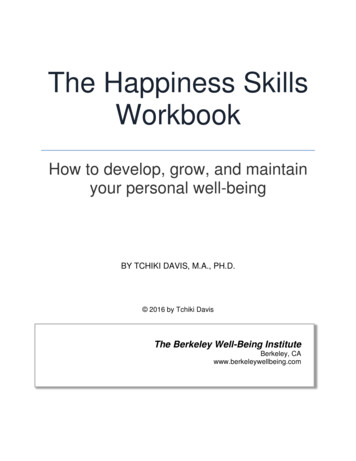
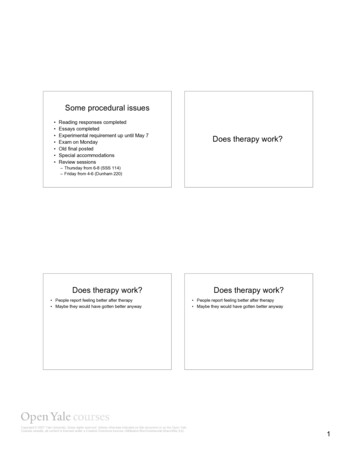




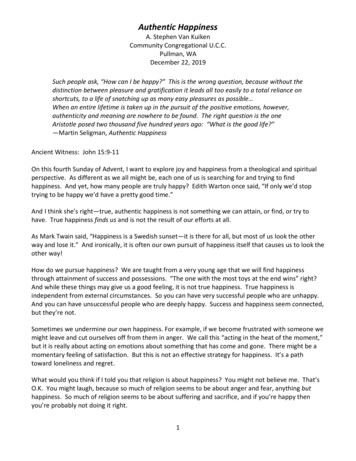
![INDEX [ actmindfully .au]](/img/14/2016-complete-worksheets-for-russ-harris-act-books.jpg)
![INDEX [thehappinesstrap ]](/img/14/complete-worksheets-2014.jpg)
